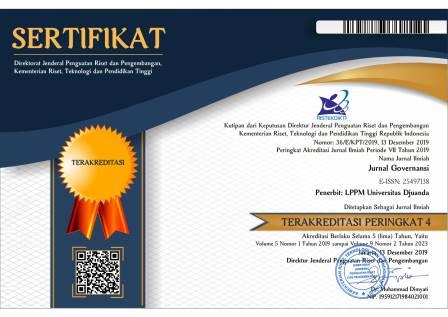IMPLEMENTASI KEBIJAKAN RUANG TERBUKA HIJAU PUBLIK OLEH DINAS KEBERSIHAN DAN PERTAMANAN KOTA BOGOR
DOI:
https://doi.org/10.30997/jgs.v2i1.196Abstract
Green Open Space (GOS) consist of public GOS and private GOS. Meanwhile, focus of this research is public GOS. To be precise, research aim is to know existing condition about the development of public GOS, to explore how the policy related has implemented, and to identify push factor and pull factor involved. Research method used is qualitative method. Snowball sampling is used to collect related data from public and employee of the Agency (Dinas Kebersihan dan Pertamanan). In addition, among public GOS purposively “active garden” have chosen as focus, that is 7 out of 32 active garden available.
This research shows that based on regulation requirement of Perda public GOS is around 20,565 % from city area. Existing condition is not ideal, still less than 11-12 % from the ideal measure. Meanwhile, based on structured interview with chosen respondent reveal that almost 60 percent of tkem is satisfy with existing condition of public garden and almost 40 percent respond reversely. Notably, respondent show their unsatisfy respond to Taman Heulang Public Garden due to the existence of street vendor (PKL), vandalism in a certain spot, and so forth.
The obstacle factor of policy implementation are the difficulties to acquire public GOS, lack of human resources, lack of coordination among local agencies, and lack of policy socialization to the public. In addition, there are conducive factor that can be boost the effective policy implementation as follows : law that induce targeted of ideal composition of public GOS, public anthusiasm to utilize existing public garden, the willingness among related parties (Central government, local government, local agency, even attentive public) to work together in implementing policy more effectively.
Keywords : Green Open Space, policy implementation, public garden
References
Budiaman, Ariev., 2010. Analisis Manfaat Ruang Terbuka HIjau Untuk
Meningkatkan Kualitas Ekosistem Kota Bogor Dengan
Menggunakan Metode GIS. Skripsi. Institut Pertanian Bogor.
Haris Indriani, Vivi, 2006. Analisis Distribusi Data dan Kecukupan Ruang
Terbuka Hijau (RTH) Dengan Aplikasi Sistem Informasi
geografis dan Penginderaan Jauh (Studi Kasus di Kota Bogor).
Skripsi. Institut Pertanian Bogor (IPB).
Iskandar. 2012. Kebijakan dan Implementasi Pemberdayaan Masyarakat
Melalui Pabrik Garam, Jurnal Sosial Humanior 3 (1): 159- 166.
Iskandar. 2013. Metodologi Penelitian Pendidikan dan Sosial. Jakarta:
Referensi.
Moleong, J. Lexy. 2015. MetodologiPenelitan Kualitatif. Bandung: PT
Remaja Rosda karya.
Mulyadi, Dedi. 2015. Studi Kebijakan Publik dan Pelayanan Publik.
Bandung: Alfabeta.
Sugiyono. 2012. Metode Penelitian Administrasi. Bandung: Alfabeta.
Suharto, Edi. 2008. Analisis kebijakan, Bandung: Alfabeta.
Undang-undang Republik Indonesia 26 Tahun 2007 Tentang Tata Ruang.
Winarno, Budi. 2012. Kebijakan Publik (Teori, Proses, dan Studi Kasus).
Jakarta: PT. Buku Seru.
Downloads
Published
How to Cite
Issue
Section
License
Authors who publish with Jurnal Governansi agree to the following terms:
- Authors retain copyright and grant the journal right of first publication with the work simultaneously licensed under a Creative Commons Attribution 4.0 International License that allows others to share the work with an acknowledgement of the work's authorship and initial publication in Jurnal Governansi.
- Authors are able to enter into separate, additional contractual arrangements for the non-exclusive distribution of the journal's published version of the work (e.g., post it to an institutional repository or publish it in a book), with an acknowledgement of its initial publication in Jurnal Governansi.
- Authors are permitted and encouraged to post their work online (e.g., in institutional repositories or on their website) prior to and during the submission process, as it can lead to productive exchanges, as well as earlier and greater citation of published work.



















